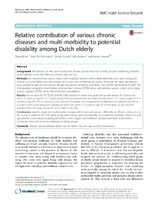Relative contribution of various chronic diseases and multi-morbidity to potential disability among Dutch elderly
Date
2018Author
Botes, Riaan
Vermeulen, Karin M.
Correia, Janine
Buskens, Erik
Janssen, Fanny
Metadata
Show full item recordAbstract
BACKGROUND: The amount of time spent living with disease greatly influences elderly people’s wellbeing, disability
and healthcare costs, but differs by disease, age and sex.
METHODS: We assessed how various single and combined diseases differentially affect life years spent living with
disease in Dutch elderly men and women (65+) over their remaining life course. Multistate life table calculations
were applied to age and sex-specific disease prevalence, incidence and death rates for the Netherlands in 2007. We
distinguished congestive heart failure, coronary heart disease (CHD), breast and prostate cancer, colon cancer, lung
cancer, diabetes, COPD, stroke, dementia and osteoarthritis.
RESULTS: Across ages 65, 70, 75, 80 and 85, CHD caused the most time spent living with disease for Dutch men
(from 7.6 years at age 65 to 3.7 years at age 85) and osteoarthritis for Dutch women (from 11.7 years at age 65 to 4.
8 years at age 85). Of the various co-occurrences of disease, the combination of diabetes and osteoarthritis led to
the most time spent living with disease, for both men (from 11.2 years at age 65 to 4.9 -years at age 85) and
women (from 14.2 years at age 65 to 6.0 years at age 85).
CONCLUSIONS: Specific single and multi-morbid diseases affect men and women differently at different phases in the
life course in terms of the time spent living with disease, and consequently, their potential disability. Timely sex and
age-specific interventions targeting prevention of the single and combined diseases identified could reduce
healthcare costs and increase wellbeing in elderly people.

